② 山东省地质调查院, 济南 250013)
介形类化石在第四纪地层中广泛分布,其对环境和气候条件的变化反应非常敏感,是重要的古环境指相化石,在海相和海陆交互相地层中,介形类区域性的分带特征可用作古海岸线、 古盐度及古水深等变化的标志[1-4]。进入第四纪以后,全球气候经历了多次冰期、 间冰期旋回,进而导致全球海平面发生变化,受区域性因素影响,不同地区地质历史时期的海面变化并不一致[5-11]。渤海莱州湾海岸带地区晚第四纪以来经历多次随气候冷暖变化而发生的海侵和海退事件,交替发育海相和陆相地层,其沉积物记录了丰富的海陆环境变化信息[12, 13]。20世纪七、 八十年代对渤海地区古气候及海平面变化的研究揭示晚第四纪以来渤海地区共记录3次海陆变化旋回,但是近期的研究对渤海莱州湾地区晚第四纪地层演化的认识,尤其是对晚更新世海相地层的年代划分存在诸多争议[14-17]。渤海湾西岸的BZ1、 BZ2和CQJ4等钻孔的磁性地层学研究也将晚更新世海侵层的年龄大大推后[18-21]。渤海莱州湾南岸LZ908孔的底栖有孔虫组合特征揭示出3套海侵地层分别对应于MIS 7、 MIS 5和MIS 1时期[22]。
因此本文根据介形虫的丰度及分异度等群落结构变化特征,结合钻孔岩性特征及测年数据,论述莱州湾晚第四纪以来的海相地层的发育特征,并进一步根据统计分析结果探讨其沉积环境演化特征,对于理解全球气候变化及渤海莱州湾南岸地区的区域响应特征具有重要的科学意义。
2 研究区域概况研究区地处于莱州湾南岸,大地构造上属于济阳坳陷和沂沭断裂带,第四纪以来的构造运动呈现出间歇性持续坳陷沉降,导致了区域地貌的分异[23]。研究区地貌变化层次清楚,由南部山前冲积-洪积平原向北过渡为冲积平原,直至莱州湾沿岸过渡为狭窄的带状冲积-海积与海积平原,地处中纬度带、 北温带季风区,属暖温带季风区半湿润大陆性气候[24, 25]。本文所选的GK95钻孔(37°10′N,118°45′E) 、 GK111钻孔(37°18′N,118°58′E) 和GK138钻孔(37°28′N,118°44′E) 位于渤海莱州湾滨海平原海岸( 图 1)。其中,GK111钻孔位于现代河口处; GK138和GK95钻孔位于现代近海平原上[27],GK138钻孔据现代海岸线18km,GK95钻孔据现代海岸线26km。研究区是由鲁中山地北麓诸河流冲积而形成的广阔平原,属于海陆交互作用地区,沉积物的沉积速率较快,沉积物能够记录海陆环境变化的详细信息[13]。

|
图 1 研究区及钻孔位置图(据文献[26]补充) Fig. 1 Map showing the location of the study area and the boreholes,modified from reference[26] |
实验样品均取自研究区钻孔,样品间隔取样深度为0.2~1.2m,共取得岩芯沉积物样品255个,每个样品重约200g。其中,GK95钻孔取样77个、 GK111钻孔取样79个和GK138钻孔取样99个。样品按照标准的微体化石分析方法进行处理。首先将样品放入60℃的烘箱恒温烘干后,称取20g干样; 泡入清水中静置3天,分散不好的样品加入少量浓度为10 % 的H2O2溶液,使样品充分散开并去除有机质; 等待样品充分分解后,使用孔径为0.150mm(100目)及0.063mm(250目)的标准网筛套叠在流水下对样品进行冲洗,最后再将筛上部分收集后置于烘箱内60℃烘干以备镜下鉴定。烘干样品在双目显微镜下进行鉴定和定量统计,原则上需要统计每个样品中介形类的全部壳体。介形类的鉴定主要依据文献 ,共16属28种。代表性属种见 图 2,具体井位和层位见 图 2说明。
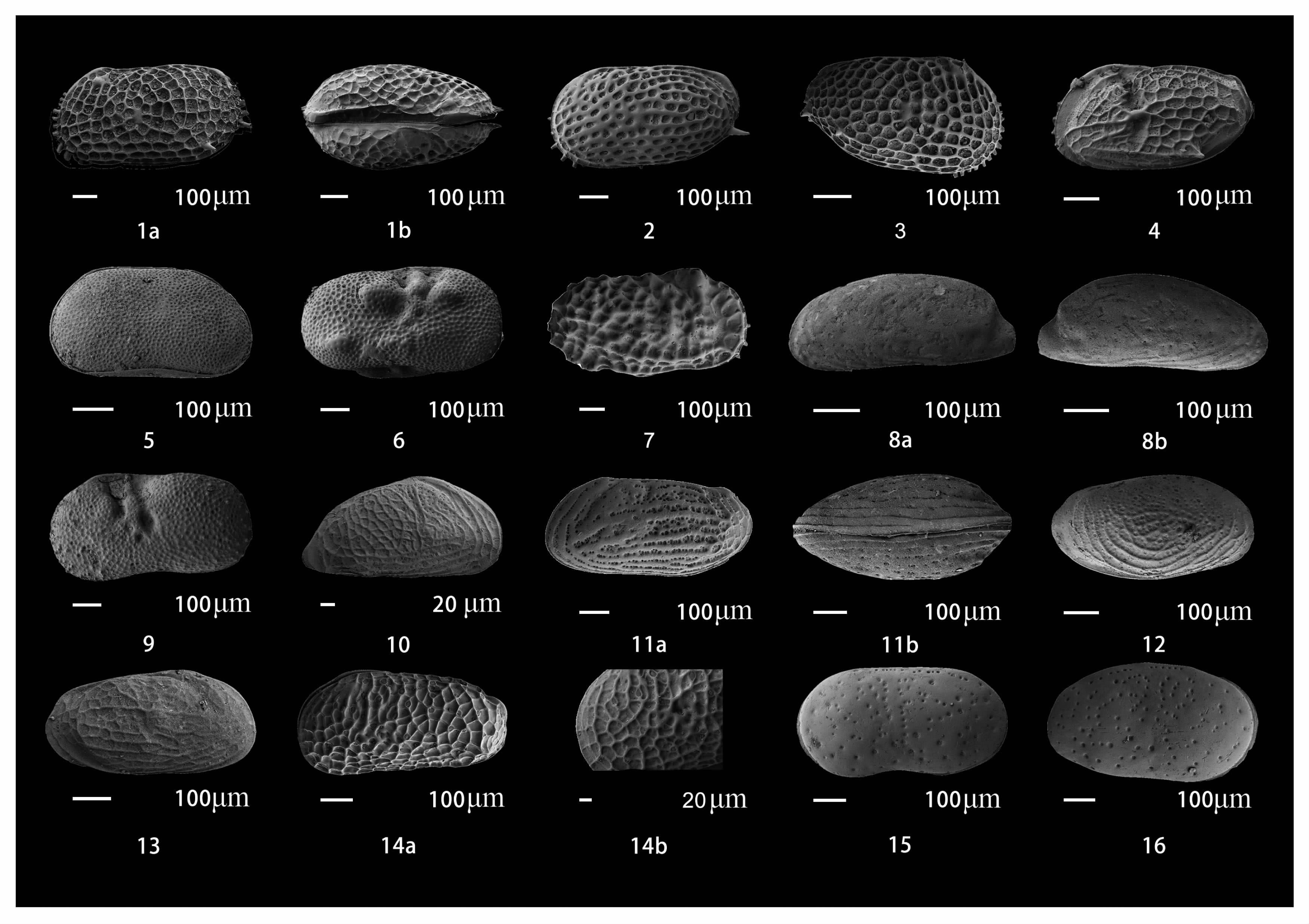
|
图 2 GK138、 GK111及GK95孔常见介形类 1. Pistocythereis bradyi(Ishizaki),1a右视,1b背视,GK95孔1.8m; 2. Bicornucythere bisanensis(Okubo),右视,GK95孔3.9m; 3. Cathetocytheretta apta(Guan),右视,GK138孔11.59m; 4. Neomonoceratina dongtaiensis(Yang et Chen),左视,GK111孔11.50m; 5. Leptocythere ventriclivosa(Chen),左视,GK95孔3.9m; 6. Ilyocypris bradyi(Sars),右视,GK138孔43.61m; 7. Neocytheretta ventripinosa (Gou,Huang et Zheng),右视,GK111孔32.56m; 8. Sinopontocythere subjaponica(Hanai),8a左视,8b右视,GK138孔48.09m; 9. Ilyocypris manasensis(Mandelstam),右视,GK111孔46.53m; 10. Sinopontocythere triangulate(Hou),右视,GK95孔2.65m; 11. Leguminocythreis reticulate(Ho),11a左视,11b口视,GK138孔49.73m; 12. Loxocoucha taiwanensis Zhao,右视,GK138孔78.60m; 13. Campylocythereis tomokoae(Ishizaki),右视,GK138孔69.25m; 14. Hemicytheridea reticulate(Kingma),14a左视,14b局部放大,GK111孔5.50m; 15. Sinocytheridea impressa(Brady),左视, GK95孔9.12m; 16. Loxoconcha ocellata(Ho),右视,GK95孔18.72m 标本保存于山东科技大学微体古生物实验室 Fig. 2 Common ostracod species of boreholes GK138,GK111 and GK95 from Laizhou Bay |
样品鉴定完成之后,使用PAleontological STatistics 3.0(PAST 3.0)软件对统计数据进行了聚类与主成分分析[36]。文中的 14 C 测年数据由美国BETA实验室利用加速器质谱碳十四(AMS)方法测定,半衰期以5730a计算( 表 1); OSL测年数据由中国地质调查局青岛海洋地质研究所测定( 表 2)。
| 表 1 研究区3口钻孔AMS 14 C年龄数据 Table 1 AMS 14 C age data of three boreholes from the study area |
| 表 2 研究区3口钻孔OSL年龄数据 Table 2 OSL age data of three boreholes from the study area |
该孔的研究深度为10.72~88.30m,99个样品中共分析出介形虫壳瓣1486枚,经鉴定海相类1052瓣,陆相类434瓣,但壳瓣破碎较严重。样品中介形类丰度最高为196瓣/20g,多数为10~30瓣/20g,简单分异度最高为8种。钻孔下部43.26~88.30m处,未获得测年数据,钻孔上部的AMS 14 C 和光释光(OSL)测年结果( 表 1和 表 2)揭示其发育于晚更新世至全新世时期。
根据钻孔中沉积物的岩性特征、 测年结果及介形虫的分布特征,该孔共揭示出3套海相地层单元,自下而上分别为第三海相地层(M3)、 第二海相地层(M2)和第一海相地层(M1)( 图 3和图 4)。
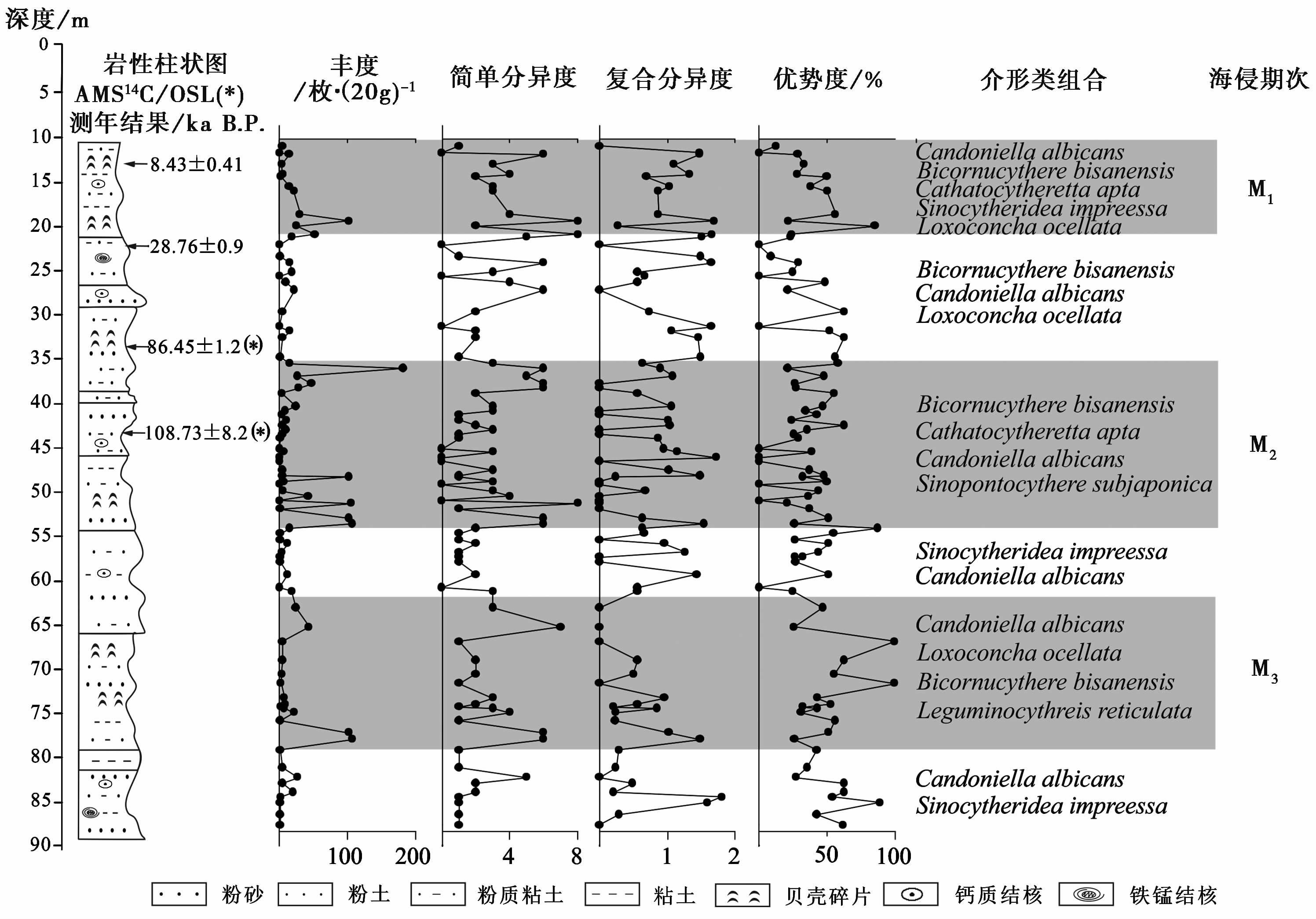
|
图 3 GK138孔沉积学及介形虫分布特征 Fig. 3 Sedimentological and micropaleontology characteristics of ostracods from borehole GK138 |
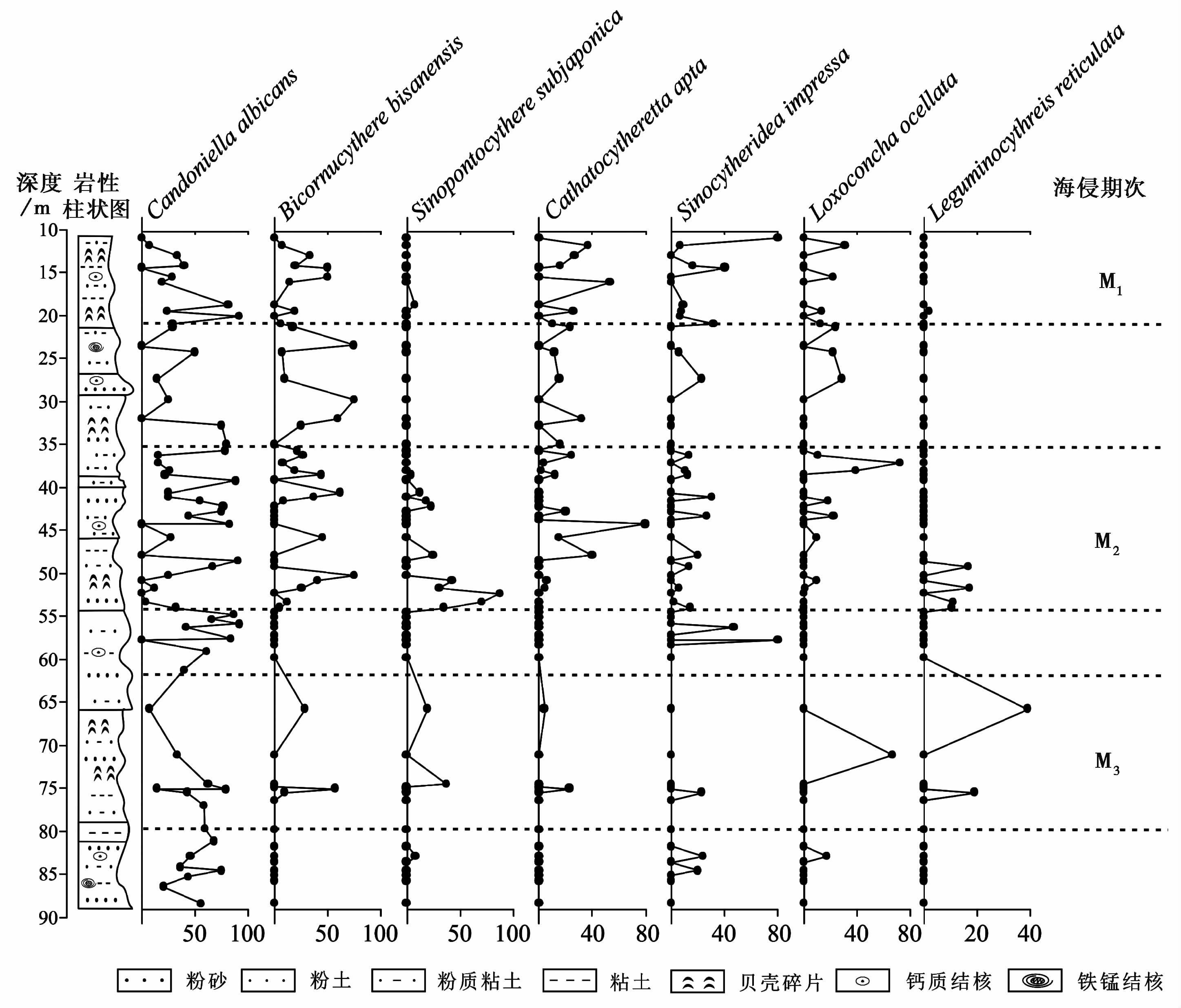
|
图 4 GK138孔介形虫相对丰度特征 Fig. 4 Relative abundance characteristics of the ostracod species of borehole GK138 |
第三海相地层埋深62.26~79.42m,地层岩性主要为棕黄色粉砂,底部发育粘土层,少量的海相贝壳碎片和生物潜穴分布于第三海相地层的中部。介形虫的丰度相对较低,仅在78.53m出现丰度的峰值,简单分异度介于2~7之间,复合分异度较低( 图 3),美山双角花介Bicornucythere bisanensis、 近日本中华海花介Sinopontocythere subjaponica、 适宜直微花介Cathetocytheretta apta和压印中华美花介Sinocytheridea impressa等广盐类介形虫[35, 37, 38]在海相层的底部出现峰值,网纹豆艳花介Leguminocythreis reticulata在海相层的顶部出现丰值,主要以纯净小玻璃介Candoniella albicans等陆相种为优势种( 图 4),说明第三海相层的沉积环境受陆相因素的影响较大,推测其沉积环境为潮上带或三角洲前缘沉积,根据与附近LZ908钻孔的对比分析[22],认为第三海相层发育于中更新世晚期,对应于MIS 7阶段[39, 40]。
4.1.2 第二海相地层第二海相地层总体埋深为35.15~54.86m,地层岩性主要为浊黄棕色粘土质粉砂,有泥质胶结和泥质团块,含海相生物碎屑及钙质结核。介形虫的丰度为15~196瓣/20g,简单分异度介于2~8之间,主要以纯净小玻璃介Candoniella albicans、 美山双角花介Bicornucythere bisanensis、 近日本中华海花介Sinopontocythere subjaponica和压印中华美花介Sinocytheridea impressa为优势种,其中近日本中华海花介Sinopontocythere subjaponica和网纹豆艳花介Leguminocythreis reticulata在海相层的底部出现丰值,适宜直微花介Cathetocytheretta apta在海相层的中部出现丰值,眼点弯贝介Loxoconcha ocellata在海相层的顶部出现丰值,而纯净小玻璃介Candoniella albicans的丰度变化则呈现相反的趋势( 图 4)。
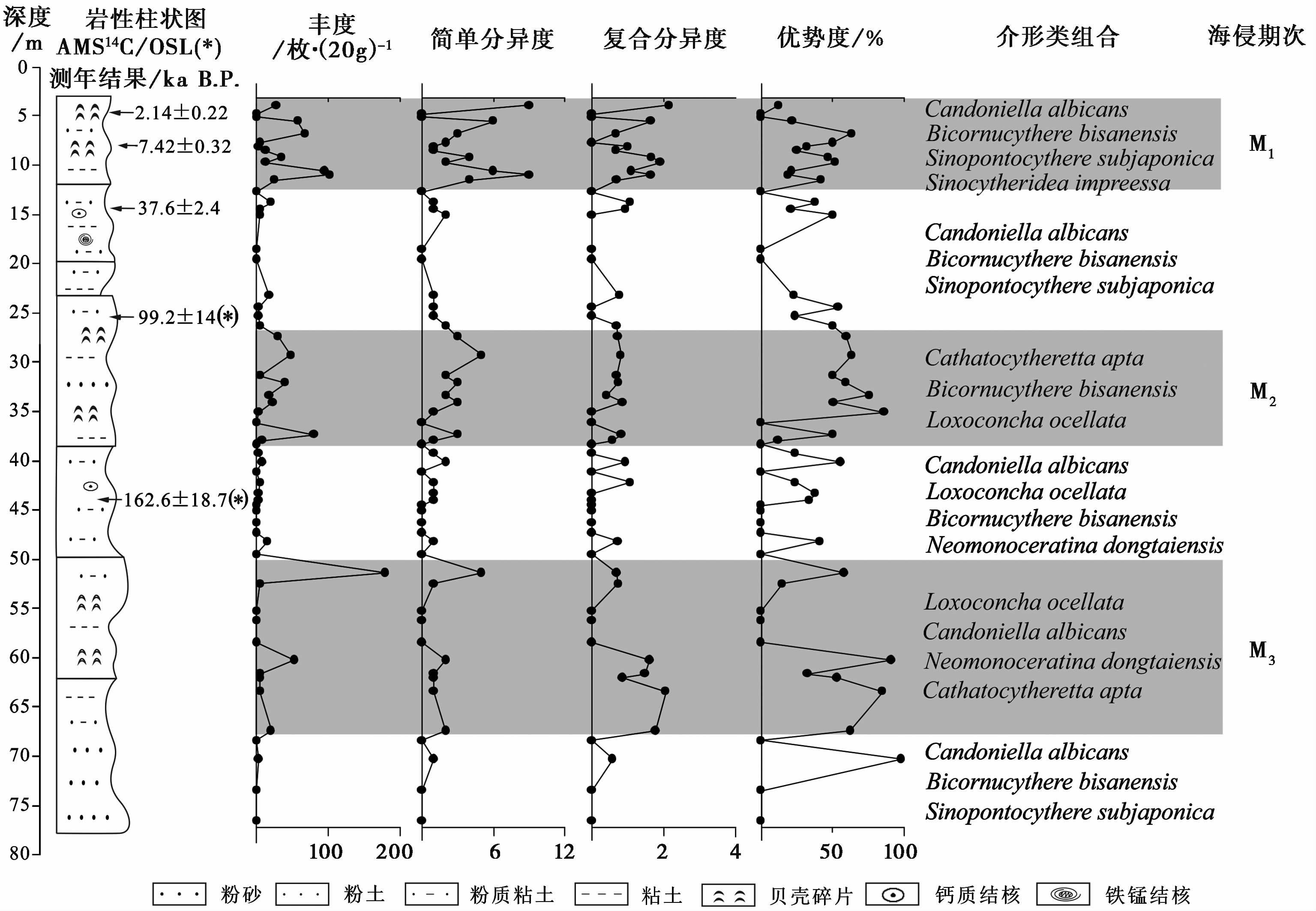
|
图 5 GK111孔沉积学及介形虫分布特征 Fig. 5 Sedimentological and micropaleontology characteristics of ostracods from borehole GK111 |
综合地层岩性及介形虫丰度和分异度分布特征,认为其沉积环境为潮下带至浅海相的沉积环境,埋深43.26m处的OSL测年值为 108.73±8.20ka,显示第二海相层发育于晚更新世时期( 图 3),对应于MIS 5阶段[39, 40]。
4.1.3 第一海相地层第一海相地层埋深为10.72~20.83m,地层岩性为棕黄色粉质粘土,含少量钙质结核和海相贝壳碎片,丰度随着深度的加深逐渐增加,最大为127瓣/20g,简单分异度介于3~8之间,复合分异度较高( 图 3)。主要以美山双角花介Bicornucythere bisanensis、 压印中华美花介Sinocytheridea impressa、 眼点弯贝介Loxoconcha ocellata和适宜直微花介Cathetocytheretta apta等海相种为优势种,纯净小玻璃介Candoniella albicans的含量随着深度的加深逐渐增加( 图 4),反映出海侵强度在逐渐减弱,综合考虑认为其沉积环境为潮间带至潮下带[38]。埋深为12.70m的AMS 14C测年值为 8.43±0.41ka,显示其发育于全新世时期,对应于MIS 1阶段[39, 40]。
4.2 GK111孔海相地层特征及沉积环境分析该孔的研究深度为3.90~77.50m,79个样品中共分析出1053枚介形虫壳瓣,经鉴定海相类812瓣,陆相类241瓣。介形类丰度最高为192瓣/20g,多数为5~20瓣/20g,简单分异度最高为10种,多数为2~6种。钻孔下部44.20~77.50m处未获得测年数据,钻孔上部的AMS 14 C 和光释光(OSL)测年结果( 表 1和 表 2)揭示其发育于中更新世至全新世时期。
根据钻孔岩性变化,测年结果和介形虫的群落结构特征,该孔亦可识别出3套海相地层单元,自下而上为第三海相地层(M3)、 第二海相地层(M2)和第一海相地层(M1)( 图 5和图 6)。
4.2.1 第三海相地层第三海相地层埋深50.48~68.75m,地层岩性主要为橄榄棕色粉质粘土,少量的海相贝壳碎片分布于第三海相地层的中部。介形虫的丰度整体较低,仅在顶部出现峰值,丰度高达183瓣/20g,简单分异度介于2~6之间,( 图 5),主要以眼点弯贝介Loxoconcha ocellata、 东台新单角介Neomonoceratina dongtaiensis和适宜直微花介Cathetocytheretta apta等海相种为优势种,并伴有少量的纯净小玻璃介Candoniella albicans( 图 6)。综合介形虫丰度及分异度等分布特征,认为该层的沉积环境为潮间带环境。根据埋深44.20m的OSL测年值为 162.6±18.7ka,并 经与邻近的LZ908钻孔对比分析[22],认为第三海相层发育于中更新世晚期,对应于MIS 7阶段[39, 40]。
4.2.2 第二海相地层第二海相层埋深26.50~38.10m,地层岩性为粉砂与粘土互层,含贝壳碎屑。介形虫丰度及分异度均较低,丰度为23~102瓣/20g,简单分异度介于1~6之间,主要以美山双角花介Bicornucythere bisanensis和适宜直微花介Cathetocytheretta apta等海相种为优势种(图 6)。总体上第二海相地层为潮下带环境。根据埋深为25.41m的OSL测年值为 99.2±14ka,并经与GK138钻孔的地层对比分析,显示第二海相层发育于晚更新世时期,对应于MIS 5阶段[39, 40]。

|
图 6 GK111孔介形虫相对丰度特征 Fig. 6 Relative abundance characteristics of the ostracod species of borehole GK111 |
第一海相地层埋深为3.90~12.70m,地层岩性为暗棕色的粉质粘土,贝壳碎屑广泛分布于海相层中上部。介形虫的丰度及分异度较高,丰度为10~120瓣/20g,简单分异度介于2~10之间,复合分异度较低,主要以东台新单角介Neomonoceratina dongtaiensis、 适宜直微花介Cathetocytheretta apta、 美山双角花介Bicornucythere bisanensis、 压印中华美花介Sinocytheridea impressa、 眼点弯贝介Loxoconcha ocellata等海相种为优势种,其含量高达80 % 以上,淡水种纯净小玻璃介Candoniella albicans仅在海相层中部出现峰值并且随着深度的加深逐渐减少(图 6),说明海侵强度逐渐增强,综合认为其沉积环境为潮间带至潮下带。埋深为4.80m和7.70m的AMS 14C测年值分别为 2.14±0.22ka和 7.42±0.32ka,显示第一海相层发育于全新世时期,对应于MIS 1阶段[39, 40]。
4.3 GK95孔海相地层特征及沉积环境分析该孔的研究深度为0.90~79.85m,77个样品中共分析出1207枚介形类壳瓣,经鉴定海相类893瓣,陆相类314瓣,介形类丰度最高为186瓣/20g,多数为5~30瓣/20g,简单分异度最高为7种,多数为3~6种。钻孔下部12.36~79.85m处,未获得测年数据,钻孔上部的AMS 14 C测年结果( 表 1)揭示其发育于全新世时期。该孔亦可识别出3套海相地层单元,自下而上为第三海相地层(M3)、 第二海相地层(M2)和第一海相地层(M1)( 图 7和图 8)。

|
图 7 GK95孔沉积学及介形虫分布特征 Fig. 7 Sedimentological and micropaleontology characteristics of ostracods from borehole GK95 |
第三海相层埋深48.60~64.60m,岩性主要为浊黄棕色粘土质粉砂,贝壳碎屑和虫孔分布于第三海相地层的上部。介形虫的丰度及分异度均较低,主要以布氏纯艳花介Pistocythereis bradyi和美山双角花介Bicornucythere bisanensis等海相种为优势种,网纹豆艳花介Leguminocythreis reticulata和三角库士曼介Cushmanidea triangulata在该层的中部出现峰值,近日本中华海花介Sinopontocythere subjaponica在顶部出现峰值(图 8),根据介形虫的群落结构特征认为该海相层的沉积环境为潮上带至潮间带。由于莱州湾南岸无明显的大的沉积间断,钻孔的岩性特征并未发生突变[24]( 图 7),并且沉积物的组成比较一致。GK95孔与GK111孔、 GK138孔相距大约30km( 图 1),所以钻孔的海相地层具有较好的可比性。根据对比分析认为第三海相层发育于中更新世晚期,对应于MIS 7阶段[39, 40]。
4.3.2 第二海相地层第二海相层埋深18.70~32.75m,地层岩性主要为黑棕色粉质粘土,贝壳碎屑主要分布于海相层的中上部,介形虫的丰度及简单分异度较低,复合分异度在海相层的底部出现峰值。主要以布氏纯艳花介Pistocythereis bradyi、 网纹豆艳花介Leguminocythreis reticulata和压印中华美花介Sinocytheridea impressa等海相种为优势种,眼点弯贝介Loxoconcha ocellata和网纹豆艳花介Leguminocythreis reticulata在海相层的顶部出现峰值(图 8)。综合岩性特征及介形虫的分布特征,认为第二海相层为潮下带环境。经与GK138和GK111钻孔的地层对比分析,认为第二海相层发育于晚更新世时期,对应于MIS 5阶段[39, 40]。
4.3.3 第一海相地层第一海相层埋深0.90~11.20m,岩性主要为棕黄色的粉砂,贝壳碎屑主要分布于海相层的中部。介形虫的丰度及分异度均较大,丰度为40~186瓣/20g,简单分异度介于3~8之间,主要以网纹豆艳花介Leguminocythreis reticulata、 布氏纯艳花介Pistocythereis bradyi和近日本中华海花介Sinopontocythere subjaponica等海相种为优势种,压印中华美花介Sinocytheridea impressa的含量随着深度的加深逐渐增加,而三角库士曼介Cushmanidea triangulata正好呈现出相反的趋势,美山双角花介Bicornucythere bisanensis和眼点弯贝介Loxoconcha ocellata在海相层的中部出现峰值(图 8)。综合考虑地层岩性和介形虫的群落结构特征认为第一海相层的沉积环境为潮上带环境。埋深为3.90m、 6.35m和12.36m的AMS 14C测年数据分别为 4.3±0.1ka、 7.82±0.40ka和 8.4±0.40ka显示第一海相层发育于全新世时期,对应于MIS 1阶段[39, 40]。
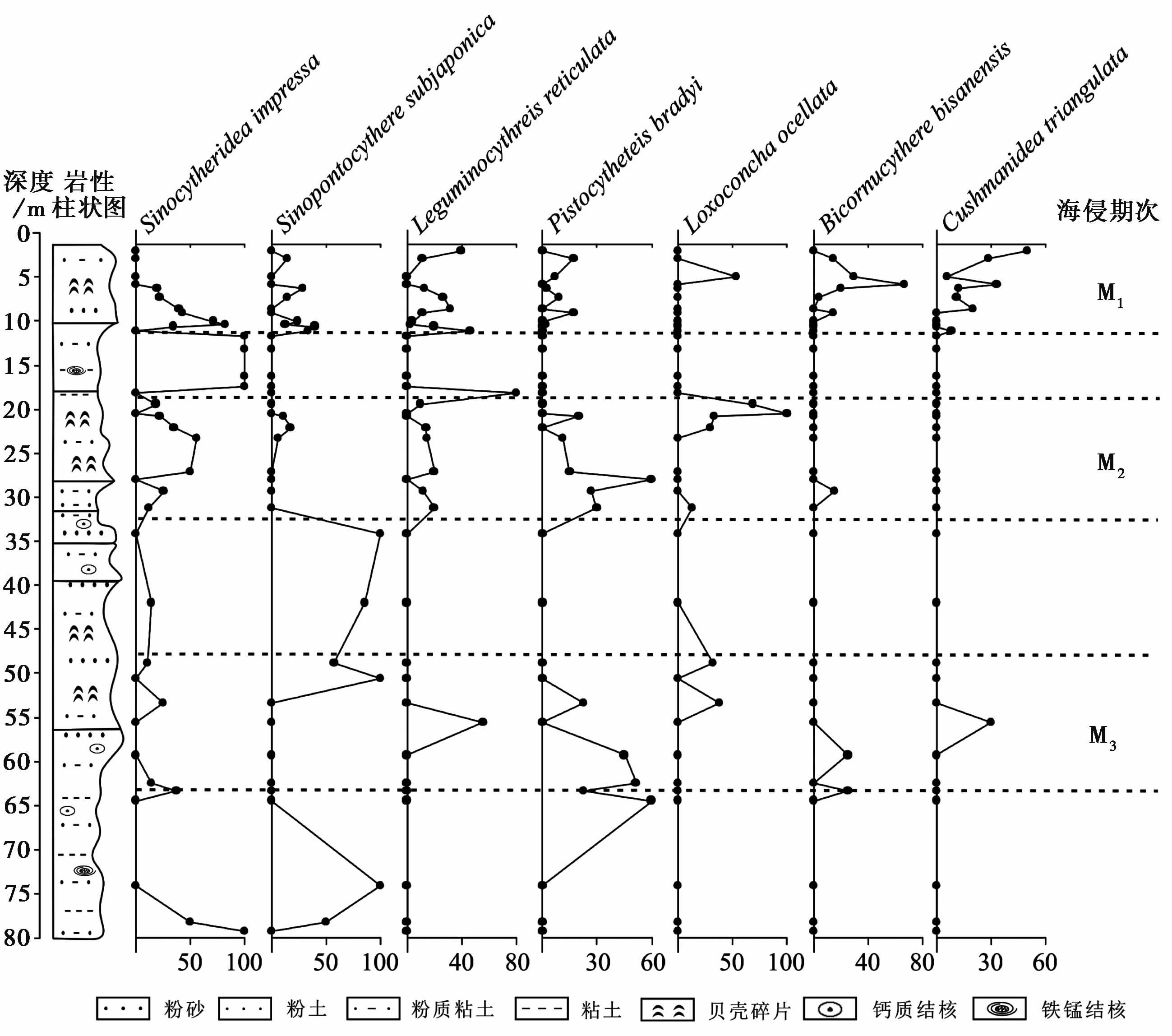
|
图 8 GK95孔介形虫相对丰度特征 Fig. 8 Relative abundance characteristics of the ostracod species of borehole GK95 |
为了进一步分析研究区内介形虫分布特征与沉积环境之间的关系,本次研究选取研究区内介形虫含量超过2 % 的样品,并将环境指示意义相近的属种进行合并,然后对于筛选后的数据利用PAST3软件进行Q型聚类分析[41-45]( 图 9)。结果表明,研究区介形类可以分为Ⅲ、 Ⅱ和Ⅰ三大化石组合带。为了进一步探讨介形虫属种含量变化与沉积环境的关系,对上述的Q型聚类结果进行了主成分分析[42](PCA分析)( 图 10和11)。

|
图 9 莱州湾GK138、 GK111及GK95钻孔样品的Q型聚类系统树图 Fig. 9 Dendrogram of Q-mode cluster analysis of the samples of boreholes GK138,GK111 and GK95 from Laizhou Bay |
该组合带中的样品主要包括GK95钻孔埋深在50.70~63.70m的样品、 GK111钻孔埋深在52.30~61.10m的样品和GK138钻孔埋深在64.52~73.26m的样品。其中纯净小玻璃介Candoniella albicans和美山双角花介Bicornucythere bisanensis占有绝对优势( 表 3)。主成分分析结果表明该化石组合带主要受到布氏形纯艳花介Pistocythereis bradyformis、 纯净小玻璃介Candoniella albicans、 压印中华美花介Sinocytheridea impressa和东台新单角介Neomonoceratina dongtaiensis的影响( 图 10和11)。Bicornucythere、 Loxoconcha及Sinocytheridea介形类组合代表滨海边缘的环境[46],根据地层岩性变化及介形虫的分布特征分析认为该组合带为潮间带沉积环境。
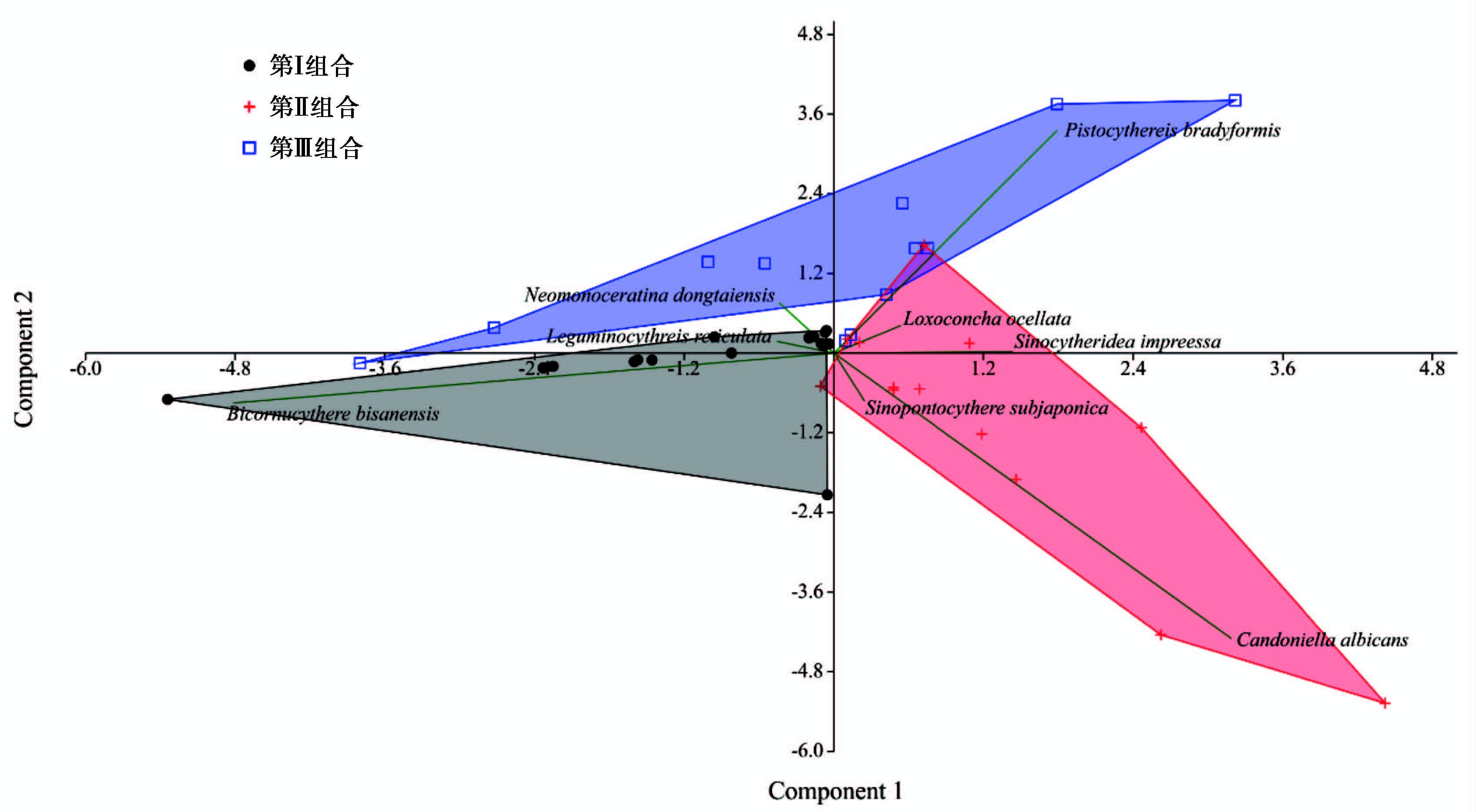
|
图 10 介形虫的主成分分析图(主成分1和主成分2) Fig. 10 Principal component analysis of the ostracod species showing principal components 1 and 2 |
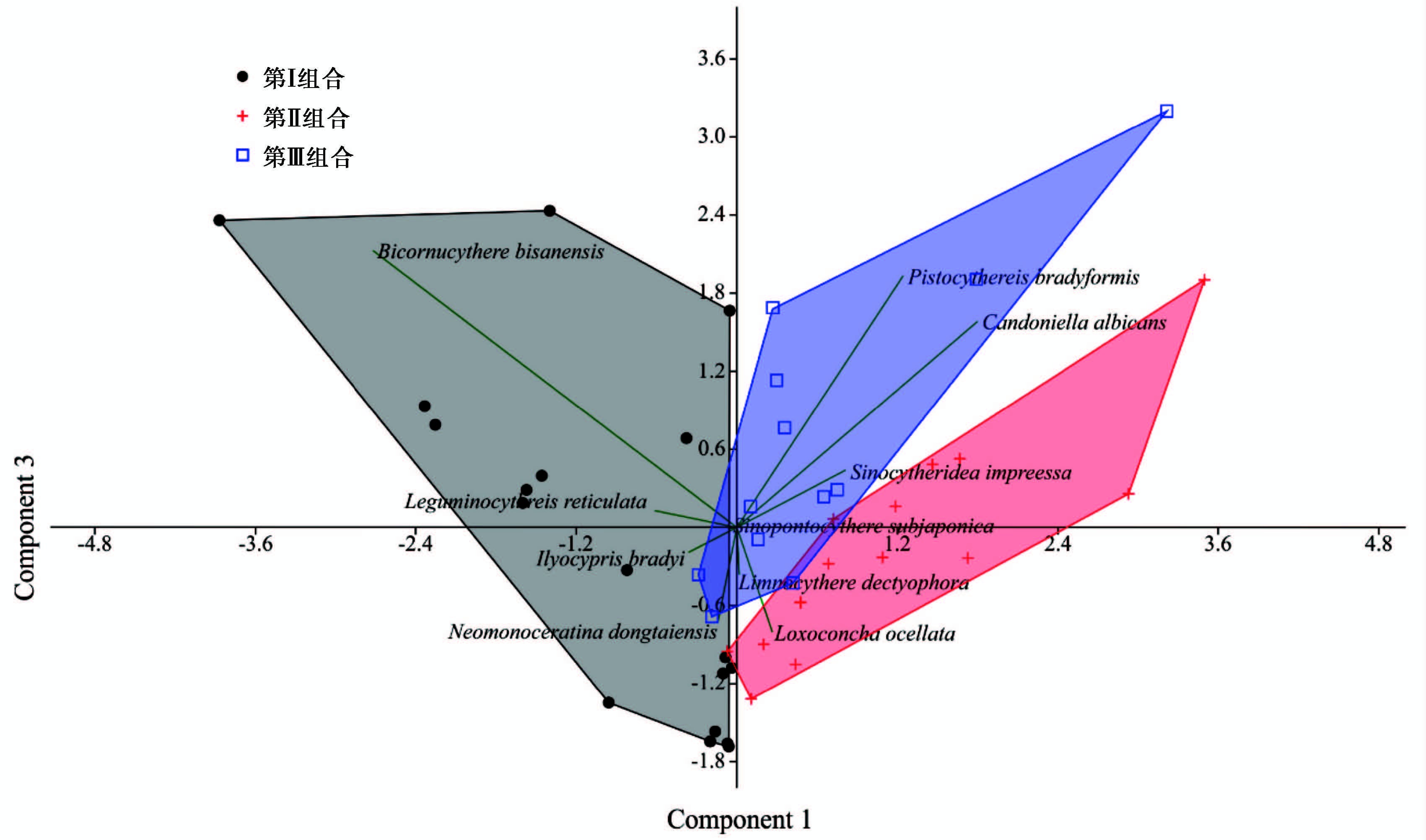
|
图 11 介形虫的主成分分析图(主成分1和主成分3) Fig. 11 Principal component analysis of the ostracod species showing principal components 1 and 3 |
该化石组合中的样品主要包括GK95钻孔埋深在19.80~28.38m的样品、 GK111钻孔埋深在28.36~32.90m的样品和GK138钻孔埋深在38.52~49.52m的样品。其中近日本中华海花介Sinopontocythere subjaponica、 布氏形纯艳花介Pistocythereis bradyformis和美山双角花介Bicornucythere bisanensis等海相种为主要优势种( 表 3)。主成分分析结果表明第Ⅱ化石组合主要受到纯净小玻璃介Candoniella albicans、 压印中华美花介Sinocytheridea impressa、 眼点弯贝介Loxoconcha ocellata和近日本中华海花介Sinopontocythere subjaponica的影响( 图 10和11),本层段介形虫化石丰度及分异度相对较小,因此其沉积环境为海水相对较深、 微体生物数量和属种较少的浅海相,为潮间带至潮下带沉积环境。
| 表 3 第Ⅲ、 第Ⅱ、 第Ⅰ化石组合中平均丰度>2 % 的介形虫物种 Table 3 The average abundance of the species >2 % of assemblages Ⅲ,Ⅱ and Ⅰ of the samples of boreholes GK138,GK111 and GK95 from Laizhou Bay |
该化石组合中的样品主要GK95钻孔埋深在0.9~9.2m的样品、 GK111钻孔埋深在6.80~10.20m的样品和GK138钻孔埋深在13.28~18.63m的样品,其中纯净小玻璃介Candoniella albicans占绝对的优势,网纹豆艳花介Leguminocythreis reticulata、 东台新单角介Neomonoceratina dongtaiensis和美山双角花介Bicornucythere bisanensis等海相种的含量高达50 % ( 表 3)。主成分分析结果表明第Ⅰ化石组合主要受到美山双角花介Bicornucythere bisanensis、 东台新单角介Neomonoceratina dongtaiensis和网纹豆艳花介Leguminocythreis reticulata等海相种的影响( 图 10和11)。以Bicornucythere为主的介形虫组合代表从潮上带、 河口、 潟湖半咸水到潮下带正常海水的广盐环境[46],结合介形虫的分异度及丰度分布变化来看,此组合带的沉积环境为气候较温暖的滨海相,为潮上带至潮间带或三角洲前缘沉积环境。
6 讨论晚第四纪以来,研究区内共发育3套海相地层,每套海相地层中3口钻孔揭示的介形类具有明显的差异特征,但它们之间又有密切的联系。为了进一步探讨每套海相地层中介形类差异性与海侵强度的关系,本文根据3口钻孔中介形类生态资料大致可以划分出广盐、 陆相和海相属种等生态类群[35, 46]。
广盐类介形虫包括美山双角花介Bicornucythere bisanensis、 眼点弯贝介Loxoconcha ocellata和压印中华美花介Sinocytheridea impressa等属种,这些介形类属种对生活的水体盐度有良好的适应性,在我国东黄海沿岸主要分布在潮上带、 潮间带、 潮下带及河口和内陆架滨岸浅海等环境。
海相介形类属种数量占优势,约占全体介形虫种数的2/3,主要有近日本中华海花介Sinopontocythere subjaponica、 布氏形纯艳花介Pistocythereis bradyformis、 网纹豆艳花介Leguminocythreis reticulata和网纹半美花介Hemicytheridea reticulata等,这些属种主要分布在水深50m以浅的近岸浅海环境。
陆相介形类主要包括纯净小玻璃介Candoniella albicans、 网纹湖花介Limnocythere dectyophora、 粗糙土星介Ilyocypris salebrosa和布氏土星介Ilyocypris bradyi等,这些属种在第四纪地层中常见于湖泊、 河流和沼泽等淡水环境中[35]。
通过对研究区3口钻孔中介形类生态特征的分类统计分析可以看出3次海侵的强度存在明显差异( 图 12): 中更新世海侵时期,GK111孔中海相和广盐类介形虫属种占全体介形虫85 % 以上,而GK138和GK95孔中含量则相对低些; 晚更新世海侵时期,3口钻孔中海相和广盐类介形虫占有绝对优势,约占全体介形类属种数量的80 % ,并且在样品出现较多的深水类介形虫(日本穆赛介Munseyella japonica),反映晚更新世海侵的强度较大,3口钻孔处于海水相对较深的沉积环境[47]; 全新世海侵时期,GK138孔中海相和广盐类介形虫属种占全体介形虫属种数量的64 % ,GK111孔中海相和广盐类介形虫属种占全体介形虫51 % ,GK95孔中占75 % ,介形虫的群落结构特征指数均显示向上减小的趋势(见 图 3、 图 5和 图 7),反映出全新世时期海侵强度逐渐减弱[48, 49],其海侵强度要明显低于晚更新世海侵。

|
图 12 研究区3套海相层介形类生态差异性特征 (a)中更新世海侵时期; (b)晚更新世海侵时期; (c)全新世海侵时期 Fig. 12 Ecological differences of the ostracod species from three marine beds in boreholes GK138,GK111 and GK95 from Laizhou Bay |
(1) 通过渤海莱州湾南岸的GK138、 GK111和GK95钻孔的255个样品中介形虫的定量鉴定与统计分析,结合钻孔岩芯的岩性变化特征,识别出莱州湾晚第四纪以来共发育3套海相地层,分别是中更新世晚期的第三海相层(M3)、 晚更新世的第二海相层(M2)和全新世的第一海相层(M1)。
(2) 结合AMS 14 C 和OSL测年结果及与研究区附近钻孔的地层对比分析,认为研究区的3套海相地层自下向上分别对应于MIS 7、 MIS 5和MIS 1的高海面阶段。通过对3口钻孔中介形虫生态特征的统计分析发现晚更新世时期海侵强度要明显强于中更新世和全新世海侵强度。
(3) 通过对介形虫含量超过2 % 的样品进行Q型聚类及主成分分析,在研究区划分出3组代表不同沉积环境的介形虫化石组合带。第Ⅲ化石组合带为中更新世晚期海侵的产物,沉积环境为潮间带滨海环境; 第Ⅱ化石组合为晚更新世海侵的产物,沉积环境为潮间带-潮下带沉积环境; 第Ⅰ化石组合带为全新世海侵的产物,沉积环境为潮上带-潮间带沉积环境。
致谢: 中国科学院南京地质古生物研究所曹美珍研究员审查了介形虫化石的鉴定结果,王春朝女士在介形虫化石电镜扫描给予指导和帮助; 审稿专家和编辑部老师对文章提出了建设性的修改意见,谨致谢忱!
| 1 |
张家武, 何晶, 陈硕, 等. 第四纪湖相介形虫类壳体化石在古环境中的应用——种属组合研究进展与问题.
地球科学进展,2009, 24 (11) : 1229~1237.
Zhang Jiawu, He Jing, Chen Shuo, et al. Applications of non-marine ostracods in Quaternary paleoenvironment——Advances and problems in fossil assemblages. Advances in Earth Science,2009, 24 (11) : 1229~1237. (  0) 0)
|
| 2 |
李军, 余俊清. 湖相介形虫古生态学在环境变化研究中的应用.
盐湖研究,2002, 10 (1) : 66~71.
Li Jun, Yu Junqing. Application of lacustrine ostracodes to the study of environmental changes. Journal of Salt Lake Research,2002, 10 (1) : 66~71. (  0) 0)
|
| 3 |
Li Xiangzhong, Liu Weiguo. Water salinity and productivity recorded by ostracod assemblages and their carbon isotopes since the Early Holocene at Lake Qinghai on the northeastern Qinghai-Tibet Plateau, China.
Palaeogeography, Palaeoclimatology, Palaeoecology,2014, 407 : 25~33.
doi:10.1016/j.palaeo.2014.04.017 ( 0) 0)
|
| 4 |
Ozawa H, Kamiya T. Ecological analysis of benthic ostracods in the northern Japan Sea, based on water properties of modern habitats and Late Cenozoic fossil records.
Marine Micropaleontology,2005, 55 (3-4) : 255~276.
doi:10.1016/j.marmicro.2005.03.003 ( 0) 0)
|
| 5 |
边叶萍, 李家彪, 翦知湣, 等. 低纬西太平洋末次冰期以来海洋孢粉记录对海平面变化的不同响应.
第四纪研究,2012, 32 (6) : 1078~1086.
Bian Yeping, Li Jiabiao, Jian Zhimin, et al. The different response of marine pollen records to the sea level change in the low latitude west Pacific since the Last Glacial period. Quaternary Sciences,2012, 32 (6) : 1078~1086. (  0) 0)
|
| 6 |
谢志仁, 袁林旺. 略论全新世海面变化的波动性及其环境意义.
第四纪研究,2012, 32 (6) : 1065~1077.
Xie Zhiren, Yuan Linwang. Fluctuation characteristics of Holocene sea-level change and its environmental implications. Quaternary Sciences,2012, 32 (6) : 1065~1077. (  0) 0)
|
| 7 |
陈中原, 刘演, 陈静, 等. 大河三角洲全新世海平面研究中的若干重要问题——以长江、尼罗河和密西西比河三角洲为例.
第四纪研究,2015, 35 (2) : 275~280.
Chen Zhongyuan, Liu Yan, Chen Jing, et al. The key issues of Holocene sea-level study of mega-deltas:Examples from Changjiang River, the Nile River and the Mississippi River. Quaternary Sciences,2015, 35 (2) : 275~280. (  0) 0)
|
| 8 |
程和琴, 陈祖军, 阮仁良, 等. 海平面变化与城市安全——以上海市为例.
第四纪研究,2015, 35 (2) : 363~373.
Cheng Heqin, Chen Zujun, Ruan Renliang, et al. Sea level change and city safety——The Shanghai as an example. Quaternary Sciences,2015, 35 (2) : 363~373. (  0) 0)
|
| 9 |
杨红强, 余克服. 微环礁的高分辨率海平面指示意义.
第四纪研究,2015, 35 (2) : 354~362.
Yang Hongqiang, Yu Kefu. High-resolution sea level changes indicative implications of microatoll. Quaternary Sciences,2015, 35 (2) : 354~362. (  0) 0)
|
| 10 |
Marco-Barba J A, Holmes J, Mesquita-Joanes F, et al. The influence of climate and sea-level change on the Holocene evolution of a Mediterranean coastal lagoon:Evidence from ostracod palaeoecology and geochemistry.
Geobios,2013, 46 (5) : 409~421.
doi:10.1016/j.geobios.2013.05.003 ( 0) 0)
|
| 11 |
杨怀仁, 陈西庆. 中国东部第四纪海面升降、海侵海退与岸线变迁.
海洋地质与第四纪地质,1985, 5 (4) : 59~80.
Yang Huairen, Chen Xiqing. Quaternary transgressions, eustatic changes and shifting of shoreline in East China. Marine Geology & Quaternary Geology,1985, 5 (4) : 59~80. (  0) 0)
|
| 12 |
王宏, 李建芬, 裴艳东, 等. 渤海湾西岸海岸带第四纪地质研究成果概述.
地质调查与研究,2011, 35 (2) : 81~97.
Wang Hong, Li Jianfen, Pei Yandong, et al. Study of Quaternary geology on the west coast of Bohai Bay. Geological Survey and Research,2011, 35 (2) : 81~97. (  0) 0)
|
| 13 |
Yao Zhengquan, Shi Xuefa, Li Xiaoyan et al. Sedimentary environment and paleo-tidal evolution of the eastern Bohai Sea, China since the Last Glaciation. Quaternary International, 2016, in press
http://cn.bing.com/academic/profile?id=2343197449&encoded=0&v=paper_preview&mkt=zh-cn ( 0) 0)
|
| 14 |
陈永胜, 王宏, 裴艳东, 等. 渤海湾西岸晚第四纪海相地层划分及地质意义.
吉林大学学报(地球科学版),2012, 42 (3) : 747~759.
Chen Yongsheng, Wang Hong, Pei Yandong, et al. Division and its geological siginificance of the Late Quaternary marine sedimentary beds in the west coast of Bohai Bay, China. Journal of Jilin University (Earth Science Edition),2012, 42 (3) : 747~759. (  0) 0)
|
| 15 |
庄振业, 许卫东, 刘东生, 等. 渤海南部S3孔晚第四纪海相地层的划分及环境演变.
海洋地质与第四纪地质,1999, 19 (2) : 27~35.
Zhuang Zhenye, Xu Weidong, Liu Dongsheng, et al. Division and environmental evolution of Late Quaternary marine beds of S3 Hole in the Bohai Sea. Marine Geology & Quaternary Geology,1999, 19 (2) : 27~35. (  0) 0)
|
| 16 |
胥勤勉, 袁桂邦, 张金起, 等. 渤海湾沿岸晚第四纪地层划分及地质意义.
地质学报,2011, 85 (8) : 1352~1367.
Xu Qinmian, Yuan Guibang, Zhang Jinqi, et al. Stratigraphic division of the Late Quaternary strata along the coast of Bohai Bay and its geology significance. Acta Geological Sinica,2011, 85 (8) : 1352~1367. (  0) 0)
|
| 17 |
阎玉忠, 王宏, 李凤林, 等. 渤海湾西岸晚更新世沉积的差异性特征.
第四纪研究,2006, 26 (3) : 321~326.
Yan Yuzhong, Wang Hong, Li Fenglin, et al. Different depositional processes of boreholes BQ1 and BQ2 in the Late Pleistocene on the west coast of Bohai Bay. Quaternary Sciences,2006, 26 (3) : 321~326. (  0) 0)
|
| 18 |
肖国桥, 郭正堂, 陈宇坤, 等. 渤海湾西岸BZ1钻孔的磁性地层学研究.
第四纪研究,2008, 28 (5) : 910~916.
Xiao Guoqiao, Guo Zhengtang, Chen Yukun, et al. Magnetostratigraphy of BZ1 Borehole in west coast of Bohai Bay, Northern China. Quaternary Sciences,2008, 28 (5) : 910~916. (  0) 0)
|
| 19 |
施林峰, 翟子梅, 王强, 等. 从天津CQJ4孔探讨中国东部海侵层的年代问题.
地质论评,2009, 55 (3) : 375~384.
Shi Linfeng, Zhai Zimei, Wang Qiang, et al. Geochronological study on transgression layers of the CQJ4 borehole at Dagang area in Tianjin, China. Geological Review,2009, 55 (3) : 375~384. (  0) 0)
|
| 20 |
李翔, 李日辉, 陈晓辉, 等. 渤海西部TJC-1孔磁性地层研究.
第四纪研究,2016, 36 (1) : 208~215.
Li Xiang, Li Rihui, Chen Xiaohui, et al. Quaternary magnetostratigraphy recorded in the sediments of core TJC-1 in the western Bohai Sea. Quaternary Sciences,2016, 36 (1) : 208~215. (  0) 0)
|
| 21 |
胥勤勉, 袁桂邦, 秦雅飞, 等. 滦河三角洲南部MT04孔磁性地层研究及其构造与气候耦合关系的探讨.
第四纪研究,2014, 34 (3) : 540~552.
Xu Qinmian, Yuan Guibang, Qin Yafei, et al. Magnetostratigraphy and discussion of coupling relationship between tectonic movement and climate change of MT04 borehole in southern Luanhe River delta. Quaternary Sciences,2014, 34 (3) : 540~552. (  0) 0)
|
| 22 |
Yao Jing, Yu Honglun, Xu Xingyong, et al. Paleoenvironmental changes during the Late Quaternary as inferred from foraminifera assemblages in the Laizhou Bay.
Acta Oceanologica Sinica,2014, 33 (10) : 10~18.
doi:10.1007/s13131-014-0536-0 ( 0) 0)
|
| 23 |
牛成民. 渤海南部海域莱州湾凹陷构造演化与油气成藏.
石油与天然气地质,2012, 33 (3) : 424~431.
Niu Chengmin. Tectonic evolution and hydrocarbon accumulation of Laizhouwan depression in southern Bohai Sea. Oil & Gas Geology,2012, 33 (3) : 424~431. (  0) 0)
|
| 24 |
吴时国, 余朝华, 邹东波, 等. 莱州湾地区郯庐断裂带的构造特征及其新生代演化.
海洋地质与第四纪地质,2006, 26 (6) : 101~110.
Wu Shiguo, Yu Zhaohua, Zou Dongbo, et al. Structural features and Cenozoic evolution of the Tan-Lu Fault Zone in the Laizhou Bay, Bohai Sea. Marine Geology & Quaternary Geology,2006, 26 (6) : 101~110. (  0) 0)
|
| 25 |
施炜, 张岳桥, 董树文. 郯庐断裂带中段第四纪活动及其分段特征.
地球学报,2003, 24 (1) : 11~18.
Shi Wei, Zhang Yueqiao, Dong Shuwen. Quaternary activity and segmentation behavior of the middle port ion of the Tan-Lu Fault Zone. Acta Geoscientia Sinica,2003, 24 (1) : 11~18. (  0) 0)
|
| 26 |
赵松龄, 杨光复, 苍树溪, 等. 关于渤海湾西岸海相地层与海岸线问题.
海洋与湖沼,1978, 9 (1) : 15~25.
Zhao Songling, Yang Guangfu, Cang Shuxi, et al. On the marine stratigraphy and coastlines of the western coast of the Gulf of Bohai. Oceanologia et Limnologia Sinica,1978, 9 (1) : 15~25. (  0) 0)
|
| 27 |
Feng Youliang, Li Sitian, Lu Yongchao. Sequence stratigraphy and architectural variability in Late Eocene lacustrine strata of the Dongying Depression, Bohai Bay basin, Eastern China.
Sedimentary Geology,2013, 295 : 1~26.
doi:10.1016/j.sedgeo.2013.07.004 ( 0) 0)
|
| 28 |
王强. 渤海湾西岸第四纪海相及海陆过渡相介形虫化石群及古地理.
海洋地质研究,1982, 2 (3) : 36~47.
Wang Qiang. The ostracod fauna of marine and marine terrestrial transitional facies in western coast of the Bohai Gulf(North China)and paleogeography during Quaternary. Marine Geological Survey,1982, 2 (3) : 36~47. (  0) 0)
|
| 29 |
庞其清, 刘俊英, 郑绵平, 等. 青藏高原昆仑山垭口地区第四纪介形虫及环境变迁的探讨.
地质学报,2007, 81 (12) : 1672~1691.
Pang Qiqing, Liu Junying, Zheng Mianping, et al. Quaternary ostracoda in the pass area of the Kunlun Mountains, northern Qinghai-Tibet Plateau, with a discussion on the environmental change. Acta Geologica Sinica,2007, 81 (12) : 1672~1691. (  0) 0)
|
| 30 |
关绍曾, 萧宗正, 张清波, 等. 北京地区第四纪早期海相介形类.
微体古生物学报,1997, 14 (2) : 191~202.
Guan Shaozeng, Xiao Zongzheng, Zhang Qingbo, et al. Early Pleistocene marine ostracods in Beijing area. Acta Micropalaeontologica Sinica,1997, 14 (2) : 191~202. (  0) 0)
|
| 31 |
赵泉鸿, 李小艳, 梅西, 等. 黄、渤海中、晚更新世的冷水介形类.
微体古生物学报,2014, 31 (4) : 373~386.
Zhao Quanhong, Li Xiaoyan, Mei Xi, et al. Middle Late Pleistocene cold water ostracoda of the Yellow Sea and Bohai Gulf. Acta Micropalaeontologica Sinica,2014, 31 (4) : 373~386. (  0) 0)
|
| 32 |
侯佑堂, 勾韵娴, 陈德琼.
中国介形类化石, 第一卷, Cypridacea和Darwinnulidacea . 北京: 科学出版社, 2002 .
Hou Youtang, Gou Yuanxian, Chen Deqiong. Ostracoda of China, Vol I Cypridacea and Darwinnulidacea. Beijing: Science Press, 2002 . (  0) 0)
|
| 33 |
侯佑堂, 勾韵娴.
中国介形类化石, 第二卷, Cytheracea和Cytherellidae . 北京: 科学出版社, 2002 .
Hou Youtang, Gou Yunxian. Ostracoda of China, Vol II Cytheracea and Cytherellidae. Beijing: Science Press, 2002 . (  0) 0)
|
| 34 |
赵泉鸿, 翦知湣, 张在秀, 等. 东海陆架泥质沉积区全新世有孔虫和介形虫及其古环境应用.
微体古生物学报,2009, 26 (2) : 117~128.
Zhao Quanhong, Jian Zhimin, Zhang Ziaxiu, et al. Holocene benthic foraminifera and ostracoda from the shelf mud area of the East China Sea and their paleoenvironmental implications. Acta Micropalaeontologica Sinica,2009, 26 (2) : 117~128. (  0) 0)
|
| 35 |
林防, 王建中, 李建芬, 等. 渤海莱州湾第四纪晚期以来微体化石组合特征和沉积环境演化.
地质通报,2005, 24 (9) : 879~884.
Lin Fang, Wang Jianzhong, Li Jianfen, et al. Characteristics of microfossil assemblages and evolution of the sedimentary environment since the Late Quaternary in the Laizhou Bay, Bohai Sea. Geological Bulletin of China,2005, 24 (9) : 879~884. (  0) 0)
|
| 36 |
Hammer O, Harper D A T, Ryan P D. PAST:Paleontological statistics software package for education and data analysis.
Palaeontologia Electronica,2001, 4 (1) : 1~248.
( 0) 0)
|
| 37 |
Casier J G, Maillet S, Kasimi R, et al. Late Eifelian and Early Givetian ostracod assemblages from Wellin, Hotton and On-Jemelle(Ardenne, Dinant Synclinorium, Belgium):Paleoenvironmental implications.
Revue de Micropaléontologie,2015, 58 (4) : 287~308.
doi:10.1016/j.revmic.2015.04.002 ( 0) 0)
|
| 38 |
林防, 李凤林, 李建芬, 等. 渤海湾西北岸全新世介形类组合特征及海进海退旋回.
地球学报,2004, 25 (1) : 53~58.
Lin Fang, Li Fenglin, Li Jianfen, et al. Holocene ostracoda assemblages and marine transgression-regression cycle in the northwestern coastal area of the Bohai Gulf. Acta Geoscientica Sinica,2004, 25 (1) : 53~58. (  0) 0)
|
| 39 |
王宏, 李凤林, 范昌福, 等. 环渤海海岸带14C 数据集(Ⅰ).
第四纪研究,2004, 24 (6) : 601~613.
Wang Hong, Li Fenglin, Fan Changfu, et al. The 14C database (Ⅰ) on the circum-Bohai Sea-coast. Quaternary Sciences,2004, 24 (6) : 601~613. (  0) 0)
|
| 40 |
王宏, 范昌福. 环渤海海岸带14C 数据集(Ⅱ).
第四纪研究,2005, 25 (2) : 141~156.
Wang Hong, Fan Changfu. The 14C database (Ⅱ) on the circum-Bohai Sea-coast. Quaternary Sciences,2005, 25 (2) : 141~156. (  0) 0)
|
| 41 |
Rossi V, Sammartino I, Amorosi A, et al. New insights into the palaeoenvironmental evolution of Magdala ancient harbour(Sea of Galilee, Israel)from ostracod assemblages, geochemistry and sedimentology.
Journal of Archaeological Science,2015, 54 : 356~373.
doi:10.1016/j.jas.2014.05.010 ( 0) 0)
|
| 42 |
Tibert N E, Rygel M C, Sanders S C, et al. Temporal and spatial distribution of ostracodes across the Pennsylvanian-Permian boundary interval in eastern North America.
International Journal of Coal Geology,2013, 119 : 93~105.
doi:10.1016/j.coal.2013.08.002 ( 0) 0)
|
| 43 |
Trabelsi K, Sames B, Salmouna A, et al. Ostracods from the marginal coastal Lower Cretaceous(Aptian)of the Central Tunisian Atlas (North Africa):Paleoenvironment, biostratigraphy and paleo ̄biogeography.
Revue de Micropaléontologie,2015, 58 (4) : 309~331.
doi:10.1016/j.revmic.2015.09.002 ( 0) 0)
|
| 44 |
Kim B, Cheong D, Lee E. Paleoenvironmental changes in northern Mongolia during the Last Deglaciation revealed by trace element records in ostracods from Lake Hovsgol.
Quaternary International,2015, 384 : 169~179.
doi:10.1016/j.quaint.2015.04.041 ( 0) 0)
|
| 45 |
Ciampo G. Ostracods as palaeoenvironmental indicators in the last 30 ky from the Tyrrhenian continental shelf.
Global and Planetary Change,2004, 40 (1-2) : 151~157.
doi:10.1016/S0921-8181(03)00105-X ( 0) 0)
|
| 46 |
李小艳, 赵泉鸿, 姚政权, 等. 渤海百万年以来的海侵记录:BH08孔有孔虫和介形类证据.
海洋地质与第四纪地质,2015, 35 (6) : 93~108.
Li Xiaoyan, Zhao Quanhong, Yao Zhengquan, et al. Transgressive records of last million year in the Bohai Sea, China:Evidence from Foraminifera and Ostracoda of core BH08. Marine Geology & Quaternary Geology,2015, 35 (6) : 93~108. (  0) 0)
|
| 47 |
于革, 叶良涛, 廖梦娜, 等. 我国沿海平原晚更新世海侵的定量重建、模拟与机制研究.
第四纪研究,2016, 36 (3) : 711~721.
Yu Ge, Ye Liangtao, Liao Mengna, et al. Quantitative reconstruction, simulation and mechanism study on the Late Pleistocene marine transgressions in the coastal plains of China. Quaternary Sciences,2016, 36 (3) : 711~721. (  0) 0)
|
| 48 |
刘艳霞, 黄海军, 董慧君, 等. 渤海西南岸全新世最大海侵界线及其地貌特征.
第四纪研究,2015, 35 (2) : 340~353.
Liu Yanxia, Huang Haijun, Dong Huijun, et al. Geomorphic characteristics and location of the maximum Holocene transgression boundary in the southwestern coast of the Bohai Sea. Quaternary Sciences,2015, 35 (2) : 340~353. (  0) 0)
|
| 49 |
胥勤勉, 胡云壮, 袁桂邦, 等. 渤海湾西南岸古黄河三角洲全新世地层层序和演化过程.
第四纪研究,2015, 35 (2) : 326~339.
Xu Qinmian, Hu Yunzhuang, Yuan Guibang, et al. Holocene sequence stratigraphy and evolution of the ancient Yellow River delta in the southwestern coast of the Bohai Bay. Quaternary Sciences,2015, 35 (2) : 326~339. (  0) 0)
|
② Shandong Institute of Geological Survey, Jinan 250013)
Abstract
The Bohai Sea is a semi-enclosed interior continental shelf sea in China which connects to the Yellow Sea by a narrow Bohai Strait.The fluvial and marine sediments were deposited during the Quaternary,which caused the complicated sedimentary evolution and the transgressions,especially Pleistocene transgressions.To clearly reveal the paleoenvironmental changes,255 sediment samples taken from new boreholes GK138(37°28'N,118°44'E),GK111(37°18'N,118°58'E) and GK95(37°10'N,118°45'E) were studied.16 genera in 28 species of ostracod fossils were identified to the species level in comparison with specimens from published illustrations.This fossil identification result together with change characteristics in lithology and accelerator mass spectrometry radiocarbon 14C and optically stimulated luminescence ages (OSL) revealed three transgressive strata.These three transgressive strata could be interpreted as the third Marine Beds (M3),the second Marine Beds (M2) and the first Marine Beds (M1) in ascending.M3 deposited in the Later Mid-Pleistocene phase,M2 in the Late Pleistocene phase and M1 in the Holocene phase.According to the chronological framework and the global sea-level change,M3,M2 and M1 corresponded well to the high sea stage of MIS (Marine Isotope Stage)7,MIS 5 and MIS 1.To investigate the relationship between the sedimentary environment and ostracod assemblages,three ostracod assemblages related to different environments were identified based on the quantitative statistical analysis (mainly Q-mode cluster and principal component analysis) of samples in which the ostracods was more than 2%.Assemblage Ⅲ was characterized by the tidal intertidal environment and a relative small scale transgression in Later Mid-Pleistocene.Assemblage Ⅱ was the product of the Late Pleistocene transgression,indicating an intertidal-subtidal environment.Assemblage Ⅰ was characterized by the supratidal-intertidal environment which mainly occurred during Holocene marine transgression.Based on the statistics of ostracod ecological characteristics data,the Late Pleistocene transgression was significantly stronger than the Later Mid-Pleistocene and the Holocene transgression. 2016, Vol.36
2016, Vol.36
